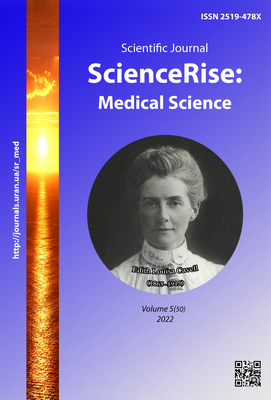Evaluation of the efficacy of paravertebral blockade as a component of combined anesthesia in the surgical treatment of pulmonary cancer
DOI:
https://doi.org/10.15587/2519-4798.2022.265238Keywords:
combined anaesthesia, total intravenous anaesthesia, inhalation anaesthesia, post-thoracotomy pain syndromeAbstract
The aim. The paper evaluates the effectiveness of implemented combined anaesthesia (inhalation with paravertebral blockade) in comparison with inhalation anaesthesia (IA) and total intravenous anaesthesia (TVA) at the stages of surgery and the early postoperative period in the surgical treatment of cancer lungs.
Methods. The study involved 60 patients with an average age of 55±5.6 years, physical status ASA II–III, who underwent open surgical interventions in the scope of frontal or pneumonectomy or resection of part of the lung. Patients were divided into 3 groups depending on the method of anaesthetic support at the stage of anaesthesia maintenance: I (n=20) – combined anaesthesia was used; II (n=20) – IA with sevoflurane; III (n=20) – TVA. In addition, the leading indicators of central hemodynamics were studied; oxygen saturation (SaO2), CO2 ET (concentration of CO2 in exhaled air), cortisol level, and indicators of acid-base status were determined. The effectiveness of analgesia in the early postoperative period was assessed using a visual analogue scale (VAS) at 10 control stages. Fasting intensity was recorded after waking up, after extubation, after 1 h. after surgery, on the first day after surgery every 3 h. and once a day from the 2nd day for 5-6 days.
Results. The studied clinical and laboratory indicators indicated an adequate course of the applied type of anaesthesia. In the dynamics of pain syndrome (PS) in the postoperative period, a gradual subjective increase of pain syndrome was noted until the 3rd day, including a decrease in pain on the 4th - 6th day. It was established that when using combined anaesthesia, a less significant level of PS, according to VAS, was noted compared to inhalation anaesthesia and the use of TVA.
Conclusions. Combined anaesthesia (inhalation with PVB) can more effectively prevent the development of post-thoracotomy pain syndrome (PTPS) compared to TVA and IA in the surgical treatment of lung cancer
References
- Global Health Estimates: Life expectancy and leading causes of death and disability (2019). WHO. Available at: https://www.who.int/data/gho/data/themes/mortality-and-global-health-estimates
- Dubowitz, J. A., Sloan, E. K., Riedel, B. J. (2017). Implicating anaesthesia and the perioperative period in cancer recurrence and metastasis. Clinical & Experimental Metastasis, 35 (4), 347–358. doi: https://doi.org/10.1007/s10585-017-9862-x
- Rak v Ukraini, 2018–2019. Zakhvoriuvanist, smertnist, pokaznyky diialnosti onkolohichnoi sluzhby (2020). Biuleten natsionalnoho kantser-reiestru Ukrainy No. 21. Kyiv: Natsionalnyi instytut raku. Available at: http://ncru.inf.ua/publications/BULL_21/index.htm
- Okada, S., Shimada, J., Kato, D., Tsunezuka, H., Teramukai, S., Inoue, M. (2017). Clinical Significance of Prognostic Nutritional Index After Surgical Treatment in Lung Cancer. The Annals of Thoracic Surgery, 104 (1), 296–302. doi: http://doi.org/10.1016/j.athoracsur.2017.01.085
- Torre, L. A., Bray, F., Siegel, R. L., Ferlay, J., Lortet-Tieulent, J., Jemal, A. (2015). Global cancer statistics, 2012. CA: A Cancer Journal for Clinicians, 65 (2), 87–108. doi: http://doi.org/10.3322/caac.21262
- Chen, W., Zheng, R., Baade, P. D., Zhang, S., Zeng, H., Bray, F. et. al. (2016). Cancer statistics in China, 2015. CA: A Cancer Journal for Clinicians, 66 (2), 115–132. doi: http://doi.org/10.3322/caac.21338
- Kritsak, V. (2020). Complications after pneumonectomy, methods of their prevention and treatment. Experimental and Clinical Medicine, 75 (2), 115–120.
- Dadyev, I. A., Davydov, М. M., Chekini, A. K., Anisimov, M. A., Gerasimov, S. S., Shogenov, M. S. et. al. (2018). Resection of tracheal bifurcation in treatment of non-small cell lung cancer (literature review). Siberian Journal of Oncology, 17 (5), 94–105. doi: http://doi.org/10.21294/1814-4861-2018-17-5-94-105
- Wu, Z., Fang, S., Wang, Q., Wu, C., Zhan, T., Wu, M. (2018). Patient-Controlled Paravertebral Block for Video-Assisted Thoracic Surgery: A Randomized Trial. The Annals of Thoracic Surgery, 106 (3), 888–894. doi: http://doi.org/10.1016/j.athoracsur.2018.04.036
- Yeung, J. H., Gates, S., Naidu, B. V., Wilson, M. J., Gao Smith, F. (2016). Paravertebral block versus thoracic epidural for patients undergoing thoracotomy. Cochrane Database of Systematic Reviews, 2 (2). doi: http://doi.org/10.1002/14651858.cd009121.pub2
- Wang, L., Bai, B., Pei, L., Tan, G., Zhang, Z., Li, X., Huang, Y. (2018). Effect of thoracic paravertebral block combined with general anesthesia on early postoperative re-covery in patients undergoing breast cancer surgery. Chinese Journal of Anesthesiology, 12, 320–323.
- Zhang, B.-Y., Zhao, D.-X. (2018). Effect of ultrasound-guided pleural paravertebral block combined with general anesthesia on serum monocyte chemokinin-1, interleukin-6 and interleukin-10 levels in patients with early breast cancer after modified radical mastectomy. Journal of Hainan Medical University, 24 (18), 64–68.
- Feng, C., Qian, D., & Chen, C. (2021). A systematic review and meta-analysis of the effects of general anesthesia combined with continuous paravertebral block in breast cancer surgery and postoperative analgesia. Gland Surgery, 10 (5), 1713–1725. doi: http://doi.org/10.21037/gs-21-272
Downloads
Published
How to Cite
Issue
Section
License
Copyright (c) 2022 Andrey Suprun, Victor Lysenko

This work is licensed under a Creative Commons Attribution 4.0 International License.
Our journal abides by the Creative Commons CC BY copyright rights and permissions for open access journals.
Authors, who are published in this journal, agree to the following conditions:
1. The authors reserve the right to authorship of the work and pass the first publication right of this work to the journal under the terms of a Creative Commons CC BY, which allows others to freely distribute the published research with the obligatory reference to the authors of the original work and the first publication of the work in this journal.
2. The authors have the right to conclude separate supplement agreements that relate to non-exclusive work distribution in the form in which it has been published by the journal (for example, to upload the work to the online storage of the journal or publish it as part of a monograph), provided that the reference to the first publication of the work in this journal is included.









